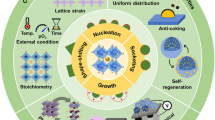Abstract
Barium titanate (BaTiO3; BT) nanoparticles were synthesized via a sol–hydrothermal microwave method, which were tetragonal phase of BT nanoparticles with an average diameter of ~50 nm. The alkalinity of the initial hydrothermal solution considerably influenced the morphologies of the BT powders. Small amount of hollow and ring-like structure was observed at 5 M. The evolution of the time-dependent morphology revealed a possible formation mechanism. An aggregation, re-alignment, and ripening process is proposed to elucidate the formation of nanoparticles with different morphologies.






Similar content being viewed by others
References
S.O. Kang et al., Growth mechanism of shape-controlled barium titanate nanostructures through soft chemical reaction. Cryst. Growth Des. 8(9), 3180–3186 (2008)
R. Asiatie et al., Characterization of submicron particles of tetragonal BaTiO3. Chem. Mater. 8(1), 226–234 (1996)
Q. Feng et al., Hydrothermal soft chemical synthesis and particle morphology control of BaTiO3 in surfactant solutions. J. Am. Chem. Soc. 88(6), 1415–1420 (2005)
F. Maxim et al., Hydrothermal synthesis and crystal growth studies of BaTiO3 using Ti nanotube precursors. Cryst. Growth Des. 8, 3309–3315 (2008)
H. Zheng, Preparation and characterization of monodispersed BaTiO3nanocrystals by sol–hydrothermal method. J. Cryst. Growth 363, 300–307 (2013)
X. Zhu et al., BaTiO3 Nanocrystals: Hydrothermal synthesis and structural characterization. J. Cryst. Growth 283(3–4), 553–562 (2005)
S. Yoon et al., Synthesis of tetragonal barium titanate nanoparticles via alkoxide–hydroxide sol-precipitation: effect of water addition. J. Am. Ceram. Soc. 90(1), 311–314 (2007)
Yang Cao et al., Hydrothermally synthesized barium titanate nanostructures from K2Ti4O9 precursors: morphology evolution and its growth mechanism. Mater. Res. Bull. 57, 162–169 (2014)
F.M. Pontes et al., Theoretical and experimental study on the photoluminescence in BaTiO3 amorphous thin films prepared by the chemical route. J. Lumin. 104, 175 (2003)
M.S. Zhang et al., Study of structural and photoluminescent properties in barium titanate nanocrystals synthesized by hydrothermal process. Solid State Commun. 119, 659–663 (2001)
A.N. Christensen et al., Hydrothermal preparation of barium titanate by transporting reactions. Acta Chem. Scand. 24(1970), 2447 (1970)
K. Kajiyoshi et al., Preparation of tetragonal barium titanate thin film on titanaium metal substrate by hydrothermal method. J. Am. Ceram. Soc. 74, 369 (1991)
M.L. Moreira et al., Hydrothermal microwave: a new route to obtain photoluminescent crystalline BaTiO3 nanoparticles. Chem. Mater. 20, 5381–5387 (2008)
Litong Guo et al., Microwave hydrothermal synthesis of barium titanate powders. Mater. Lett. 60, 3011–3014 (2006)
D. Keyson et al., Domestic microwave oven adapted for fast heat treatment of Ba0.5Sr0.5(Ti0.8Sn0.2)O3 powders. J. Mater. Process. Technol. 189, 316–319 (2007)
S. Komarneni et al., Microwave–hydrothermal synthesis of ceramic powders. Mater. Res. Bull. 27, 1393–1405 (1992)
S. Komarneni et al., Microwave–hydrothermal processing of titanium dioxide. Mater. Chem. Phys. 61, 50–54 (1999)
B.L. Newalkar et al., Microwave–hydrothermal synthesis and characterization of barium titanate powders. Mater. Res. Bull. 36, 2347–2355 (2001)
Weian Sun et al., Preparation of fine tetragonal barium titanate powder by a microwave–hydrothermal Process. J. Am. Chem. Soc. 89, 118–123 (2006)
Ying Ma et al., Synthesis of tetragonal BaTiO3 by microwave heating and conventional heating. Chem. Mater. 9, 3023–3031 (1997)
C.H. Perry et al., Temperature dependence of the Raman spectrum of BaTiO3. Phys. Rev. Lett. 15(17), 700–702 (1965)
Y. Ma et al., Synthesis of tetragonal BaTiO3 by microwave heating and conventional heating. Chem. Mater. 9(12), 3023–3031 (1997)
V. Bansal et al., Temperature biosynthesis of ferroelectric barium titanate nanoparticles. J. Am. Chem. Soc. 128(36), 11958–11963 (2006)
Shicheng Zhang et al., Formation mechanisms of SrTiO3 nanoparticles under hydrothermal conditions. Mater. Sci. Eng. B 110, 11–17 (2004)
Yang Cao et al., Fabrication of BaTiO3 nanoparticles and its formation mechanism using the high temperature mixing method under hydrothermal conditions. Adv. Powder Technol. 25, 853–858 (2014)
R.L. Penn et al., Epitaxial assembly in aged colloids. J. Chem. Phys. B 105(11), 2177–2182 (2001)
Acknowledgments
This work was supported by the National Nature Science Foundation of China (NSFC Nos. 51372114, 51202118), the Doctoral Fund of the Ministry of Education of China (Grant No. 20120002120012).), A Project Funded by the Priority Academic Program Development of Jiangsu Higher Education Institutions (PAPD), the NUAA Fundamental Research Funds (Nos. NN2012018, NP2013301).
Author information
Authors and Affiliations
Corresponding author
Rights and permissions
About this article
Cite this article
Xu, L., Zhu, K., Wang, J. et al. Microwave-assisted sol–hydrothermal synthesis of tetragonal barium titanate nanoparticles with hollow morphologies. J Mater Sci: Mater Electron 26, 1597–1601 (2015). https://doi.org/10.1007/s10854-014-2581-z
Received:
Accepted:
Published:
Issue Date:
DOI: https://doi.org/10.1007/s10854-014-2581-z




